 W
WAspiolucius esocinus or the pike asp is a species of cyprinid fish native to rivers and occasionally lakes in Tajikistan, Kazakhstan, Turkmenistan, and Uzbekistan. This species can reach a total length of 50 cm (20 in).
 W
WAsterropteryx ensifera, known commonly as the Miller's damsel , is a species of marine fish in the family Gobiidae.
 W
WBagropsis reinhardti is a species of long-whiskered catfish. This species reaches about 22.7 cm (8.9 in) in standard length and is endemic to Brazil where it is found in the Das Velhas River basin in São Francisco River drainage. It is considered a threatened species by Brazil's Ministry of the Environment.
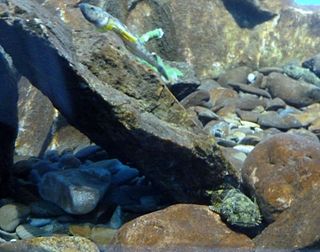 W
WThe Baikal yellowfin, also known as the yellow-finned sculpin or yellow-wing sculpin, is a species of cottoid fish that is endemic to Lake Baikal and its tributaries in Siberia, Russia. It is most common in the southern part of the lake and lives from near the shore to a depth of 300 m (980 ft).
 W
WThe band cusk-eel is a fish species in the family Ophidiidae. Widespread in the Western Atlantic from North Carolina, United States, and northern Gulf of Mexico to southeastern Brazil. Absent from The Bahamas. Marine reef-associated tropical demersal fish, up to 30 cm (12 in) long.
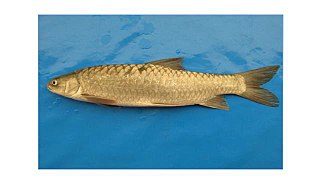 W
WThe binni is a species of cyprinid fish endemic to the Tigris–Euphrates Basin in the Middle East. This fish mostly inhabits lakes and marshes, especially in densely vegetated places where it also lays its eggs, but periodically it moves into rivers. This barbel is the only member in its genus, but was included in the "wastebasket genus" Barbus by earlier authors. It has declined in recent times due to habitat loss and overfishing.
 W
WThe Bonneville cutthroat trout is a subspecies of cutthroat trout native to tributaries of the Great Salt Lake, U.S.A. Most of the fish's current and historic range is in Utah, but they are also found in Idaho, Wyoming, and Nevada. This is one of 14 or so recognized subspecies of cutthroat trout native to the western United States.
 W
WThe boopis razorbelly minnow is a species of cyprinid fish in the genus Salmostoma. It is widespread throughout the Western Ghats of India
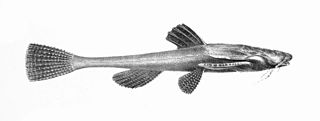 W
WBunocephalus coracoideus, the guitarrito, is a species of banjo catfish found in the Amazon River basin. It occurs in Bolivia, Brazil, Peru and Uruguay where it is found in ponds and creeks that contain a large quantity of plant debris. Its diet varies, and may include organic debris from the bottom.
 W
WCarasobarbus fritschii is a species of ray-finned fish in the family Cyprinidae. It is found only in the upper parts of the rivers of Morocco. Its natural habitat is rivers.
 W
WChaetodon trichrous is a species of fish in the family Chaetodontidae.
 W
WThe Chinese minnow is an Asian species of small freshwater cyprinid fish. It is found from the Amur rivers in the north to the Yangtze in China in the south.
 W
WCladodus is an extinct genus of cartilaginous fishes in the family Cladoselachidae. As the name implies, they are a type of cladodont, primitive sharks with teeth designed to snag fish and swallow them whole, instead of sawing off chunks to swallow.
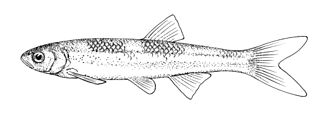 W
WThe comely shiner is a small species of North American fish belonging to the family Cyprinidae.
 W
WCoregonus baicalensis is a species of freshwater whitefish in the family Salmonidae. It is endemic to the Russian Federation's Lake Baikal where it is found on the bottom demersal. The maximum length recorded for this species is 60 centimetres (24 in). The average length is a few centimetres above 50 centimetres (20 in). It is also known as the Baikal whitefish. It is frequently considered to be a subspecies of Coregonus lavaretus.
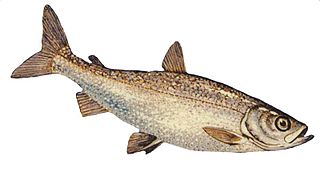 W
WCoregonus hoyi, also known as the bloater, is a species or form of freshwater whitefish in the family Salmonidae. It is a silvery-coloured herring-like fish, 25.5 centimetres (10.0 in) long. It is found in most of the Great Lakes and in Lake Nipigon, and inhabits underwater slopes. This fish is not to be confused with the extinct deepwater cisco, a large fish that shared a common name with the bloater.
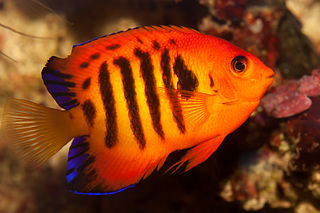 W
WThe flame angelfish is a marine angelfish of the family Pomacanthidae found in tropical waters of the Pacific Ocean. Other common names include flame angel, flaming angelfish and Japanese pygmy angelfish.
 W
WFranciscodoras marmoratus is the only species in the genus Franciscodoras of the catfish family Doradidae. This species is endemic to Brazil where it is found in the São Francisco River basin and reaches a length of 36.0 centimetres (14.2 in) TL.
 W
WFranciscodoras marmoratus is the only species in the genus Franciscodoras of the catfish family Doradidae. This species is endemic to Brazil where it is found in the São Francisco River basin and reaches a length of 36.0 centimetres (14.2 in) TL.
 W
WFries's goby is a species of goby native to the Eastern Atlantic Ocean along the coasts of Europe and northern Africa as well as the Mediterranean Sea to the Sea of Marmara. This species burrows into muddy or muddy sand substrates at depths of from 10 to 130 metres and is frequently found in association with the Norway lobster Nephrops norvegicus. This species can reach a length of 13 centimetres (5.1 in) TL. The specific name honours the Swedish zoologist Bengt Fredrik Fries (1799-1839).
 W
WThe grunt sculpin or grunt-fish is a small fish mainly found in the eastern Pacific Ocean. The grunt sculpin generally remains close to shore and is often found in empty giant barnacle shells. It was first identified by Albert Günther in 1874 and was named in honor of naturalist John Richardson. The common name comes from reports that the fish vibrate or "grunt" when held. Its defining feature is its tendency to “hop” along the ocean floor on its orange fins. The short, stout body of the grunt sculpin has a long, small mouth which is adapted for eating smaller prey.
 W
WHypselobarbus lithopidos is a species of ray-finned fish in the genus Hypselobarbus. It is possibly extinct as it has not been recorded since the 1940s and its true taxonomic status needs to be ascertained.
 W
WHypselobarbus thomassi is a critically endangered species of ray-finned fish in the genus Hypselobarbus. It is endemic to the Western Ghats in Karnataka and Kerala, India. This species is potentially a very large fish, growing to 100 cm (39 in) TL, possibly even larger.
 W
WJinshaia sinensis is a species of loach endemic to the Yangtze and the Jinsha Jiang drainages of China.
 W
WThe least chub is a species of ray-finned fish in the family Cyprinidae, the only member of the genus Iotichthys.
 W
WLiparis agassizii, in one instance called "agassiz's snailfish", is a fish from the genus Liparis. It lives in the North Pacific Ocean at a depth range between zero and one hundred meters. The fish may especially be found from the Iwate Prefecture to Hokkaido, off the coast of Primorskiy, off the western and southeastern coast of Sakhalin, and in the southern Kuril Islands.
 W
WLiparis antarcticus is a fish from the genus Liparis. It is a marine fish that lives in the demersal zone. Liparis antarcticus can be found in the Southeast Pacific Ocean by Chile, and it is the only known species from its genus to live in the Southern Hemisphere.
 W
WThe Little Colorado spinedace is a species of ray-finned fish in the family Cyprinidae. It is found only in Arizona in the United States.
 W
WLuciobarbus nasus is a ray-finned fish species in the family Cyprinidae. It is found only in Morocco.
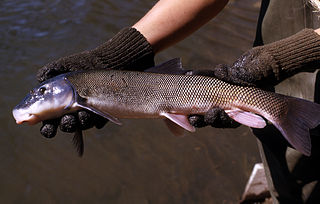 W
WThe mountain sucker is a sucker found throughout western North America, on both sides of the Rocky Mountains, including the upper Missouri River, Columbia River, Sacramento River, and Colorado River. It is not limited to higher altitudes but is known from locations as high as 2,800 m (9,200 ft). It is a slender, streamlined fish typically under 20 cm (8 in) in length. It is generally olive green or brown above, with pale underparts, and breeding males have a lateral red-orange band and fins suffused with the same color. It is mainly herbivorous, feeding on algae and diatoms. Breeding takes place in late spring and early summer in gravelly riffles in small streams.
 W
WThe mushroom goby is a species of goby native to the Black Sea where it can be found along the coasts from Bulgaria to the Crimea. Mostly a species of marine and brackish waters, it is known to enter fresh waters in the delta of the Danube River. This species prefers inshore waters with rocks or fallen trees. This species can reach a length of 20 centimetres (7.9 in) TL.
 W
WPonticola cyrius, the Kura goby, is a species of gobiid fish endemic to the Kura River in the southern Caucasus countries of Georgia, Turkey, Iran and Azerbaijan. It reaches a length of 13 centimetres (5.1 in) SL. It lives in the upper parts of the Kura River, Massuleh River and the Pasikhan River and in the Anzali Mordab (Iran). Downstream in Kura it is replaced by Ponticola gorlap.
 W
WThe Remo flounder, Oncopterus darwinii, is an edible flatfish of the family Pleuronectidae. It is a demersal fish that lives on bottoms at depths of between 20 and 80 metres. Its native habitat is the southwestern Atlantic along the southeast coast of South America, from Santa Catarina, Brazil in the north to the San Matías Gulf, Argentina in the south. It can reach 30 centimetres (12 in) in length.
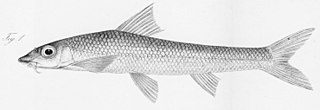 W
WRhinogobio ventralis is a species of cyprinid fish endemic to the middle and upper reaches of the Yangtze in China.
 W
WThe sailfin snapper or blue-lined sea bream is a species of snapper native to the Indo-Pacific region. It inhabits coral reefs in areas with sand substrates at depths from 5 to 60 m. It is a solitary fish, only coming together with others of its species to spawn. This species can reach a length of 60 cm (24 in). Its body shows blue undulating stripes over a yellow body, an orange stripe crossing the eye, and another one at the back of the head. It has typically a black spot at its tail. It is of minor importance to local commercial fisheries and can be found in the aquarium trade. It is currently the only known member of its genus.
 W
WEquulites elongatus, the slender ponyfish, also called the elongate ponyfish, elongate slimy or elongated slipmouth, is a marine fish of the family Leiognathidae native to the western Pacific and Indian Oceans.
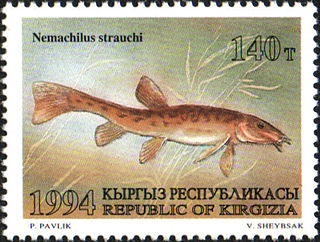 W
WSpotted thicklip loach is a species of ray-finned fish in the genus Triplophysa. It is widespread in the basins of Balkhash, Issyk-Kul, Sassyk-Kul and Ala-Kul, and basins of Lake Zaysan, in Tarim basin. It can grow up to 25 cm in length.
 W
WSqualidus argentatus is a species of cyprinid fish endemic to China, Russia, and Taiwan.
 W
WThe stellate tadpole-goby is a species of gobiid fish native to the basin of the Sea of Azov where it occurs in the Gulf of Taganrog and limans of the eastern coast. It also lives in the lower Don River up to the Tsimlyansk Reservoir. It occurs in fresh and brackish waters of depths greater than 3 metres (9.8 ft), preferring shallow coastal lagoons and lowland rivers. Males can reach a length of 13.5 centimetres (5.3 in) TL while females only reach 11 centimetres (4.3 in) TL.
 W
WThe swallowtail hawkfish, Cyprinocirrhites polyactis, is a species of hawkfish native to tropical reefs of the Indian Ocean and the western Pacific Ocean. This species grows to 15 cm (5.9 in) in total length. It is also found in the aquarium trade. This species is the only known member of its genus.
 W
WThe torrentfish, or panoko (Māori), is an amphidromous freshwater fish that is endemic to New Zealand. Torrentfish are well adapted to life in shallow, fast-flowing riffles and rapids. They grow to a maximum of 20 cm (7.9 in) in total length, but more commonly reach 10–12 cm (3.9–4.7 in).
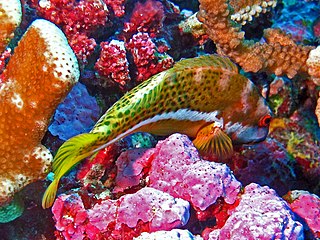 W
WThe whitespot hawkfish, also known as the halfspotted hawkfish, multicolored hand-fish and ornate hawkfish, is a species of hawkfish belonging to the family Cirrhitidae.
 W
WThe woundfin is a species of minnow endemic to the Virgin River of the southwestern United States. It is the only species in the monotypic genus Plagopterus.